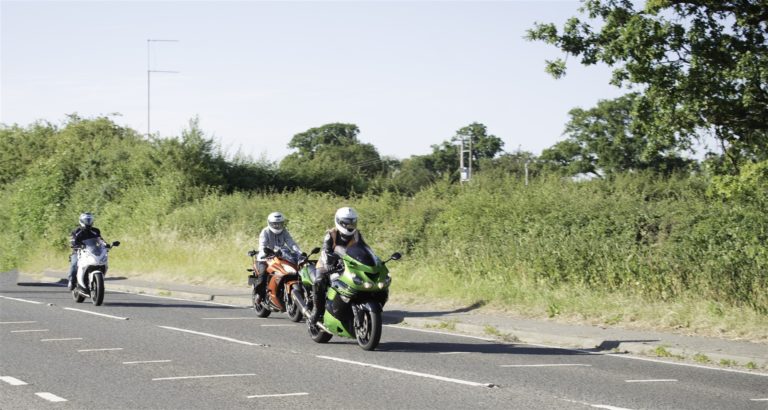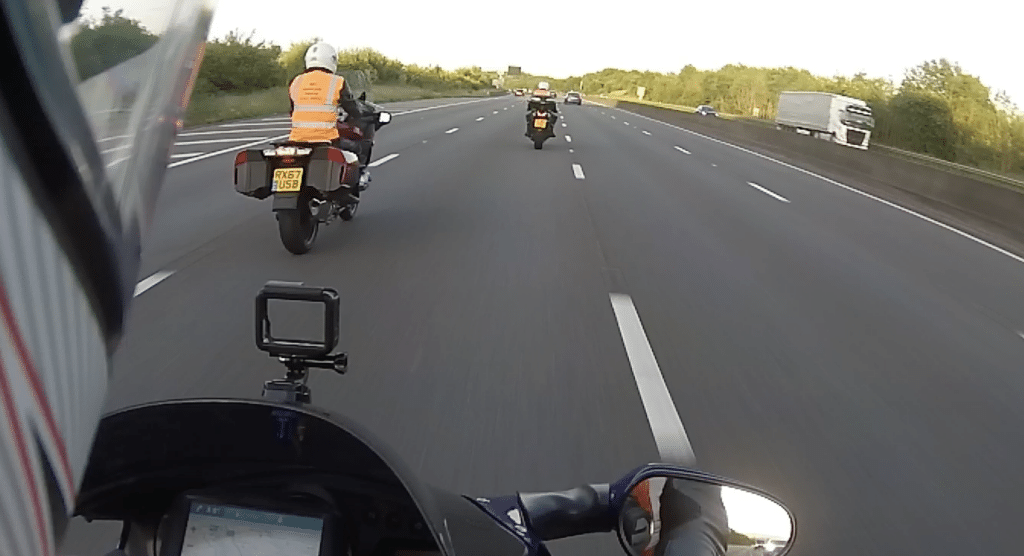

Navigating motorways and dual carriageways as a motorcyclist demands a distinctive set of skills and a heightened level of awareness. Riders think riding a motorcycle on motorways and dual carriageways is safe but when it goes wrong, it can be catastrophic.
These high-speed, multiple-lane roadways can present rapidly developing situations. Good awareness, vision and planning are all key attributes that riders must learn and understand. It requires an intuitive understanding of the machine and the surrounding environment.
This article provides a comprehensive overview of the complexities of riding on motorways and dual carriageways. It will help to equip you with the knowledge and skills necessary to tackle them with confidence.
Entry and exit points on motorways and dual carriageways pose significant challenges. If you have ever noticed where the speed limit signs are, that is a clue to how to use a slip lane.
Many people get this wrong and do not use slip lanes correctly. This is why there are many problems as you approach a slip lane on a motorway or dual carriageway. People in vehicles do not speed up to enter or use the slip lane properly to slow down, instead they slow down on the carriageway instead of the slip lane.
Entering the slip lane requires good vision and observation. You must try to match the speed of the inside lane of the carriageway, this will allow you to filter safely into the gap between traffic. If you can’t join you should give way and stop if necessary (although vehicles do not do this and force their way in.)
You must master the use of slip lanes to join the flow of traffic smoothly. This will prevent you or others from taking evasive action to miss a collision. Good awareness riding a motorcycle on motorways and dual carriageways and an understanding of others’ mistakes and common problems, will allow you to judge what is happening at that precise moment.
The key is to be prepared, anticipate potential hazards and understand the behaviour of other road users. The problems arise when people are not educated and do what they think is right.
Over 95% of vehicle drivers on the road have not done any further training other than the basic driving/riding test. This is a staggering amount of people who only have a very basic understanding of how to use the road correctly.
Never taking any further education means their knowledge is still at a very low standard and so is their driving. You must be able to observe and evaluate what is going on around you and have a plan of action in place to remain safe and out of harm’s way.
When an incident occurs on a faster road like the motorway or dual carriageway, the consequences are severe. This is because of the speed involved, the lack of distance between vehicles and the fact that many drivers are not properly tuned in to their surroundings.
There is a distinct difference when riding a motorcycle on motorways and dual carriageways, when it comes to central reservations.
On a motorway the central reservation is unbroken. The only way you can cross this area is if there are roadworks and you are forced to cross to the other carriageway if the road is closed. This would be for long term or ongoing road works.
The reason this system is used is to enable the work force to operate in safety. It also allows the traffic flow to be maintained to prevent deviations from the motorway.
On a dual carriageway there are times when you may be able to cross the carriageway in a created gap. This is for vehicles to turn right off the carriageway or turn across it to get to the opposite side.
These crossing areas are dangerous, as vehicles may be travelling slowly as they pull away from being stationary. Vehicles on the carriageway travel quickly and the closing speeds on slower moving traffic can be very high indeed.
Also drivers of other vehicles may misjudge the speed of faster moving traffic and may pull across their path thinking they have enough time. Talk care when riding near gaps in the central reservation and be aware of sudden movement from traffic making last second decisions.
Smart motorways are the next evolution in highway traffic management. They are designed to employ technology to monitor and manage traffic flow. This is supposed to reduce traffic congestion and increase safety for all road users.
This doesn’t always work, especially with the heavy volume of traffic in some areas. The main reason is rush hour traffic or if there has been an incident. Quick traffic build up can catch it out and stand stills are still common in some areas.
As a rider, understanding how smart motorways operate is crucial. This includes interpreting the dynamic speed limits displayed on gantries. As the speed is reduced it is there to slow down the traffic before the congestion starts.
In some cases the hard shoulder is opened to help ease congestion. This opens a fourth lane and in some cases more lanes. The intention is to accommodate the high levels of traffic.
Knowing when and how to use the hard shoulder as a running lane is important but caution is required for all riders as the lane is not used frequently and you may pick up debris which causes punctures. You will be vulnerable if you need to stop on a live motorway.
React appropriately to red X signals indicating lane closures. Some drivers do not know what it means or ignore it. Caution must be taken when near these areas as traffic may suddenly move over from the hard shoulder.

Effective lane discipline is important for a rider’s safety. There may be times when you ride in the centre of the lane to equalise the dangers either side and there are times when you would move to a left or right hand wheel track in the lane you are using.
The movement within the lane is to protect your space and to keep you away from other traffic. The reason you would move from large vehicles is because of the wind vortex and down draft and if there was a faster moving vehicle overtaking close enough to be an issue, you’d move away for your safety.
Not swapping lanes constantly minimises the need to move unnecessarily. Hogging the outside lane when not overtaking should be avoided. But with good vision and planning you can reduce the amount of movement by reading the road ahead.
As a rider, you should aim to stay within your lane. Aim to use the overtaking lane only when necessary and returning to the left-hand lane once the manoeuvre is complete. You can stay in the middle lane (known as lane two) if you are passing slower traffic in lane one.
Overtaking is a skill that must be practised and perfected. The faster moving traffic means things change very quickly and can catch you out of your vision and panning is poor. Being able to scan properly and judge the speed of the traffic is key for survival on this dangerous section of road.
Adverse weather conditions can dramatically affect the riding experience of riding a motorcycle on motorways and dual carriageways. Keeping the correct distance will reduce rider risk and giving adequate braking distances will keep you out of harm’s way.
Rain can reduce visibility and increase standing water making stopping distances much longer. Be aware of heavy rain that can cause spray, vehicles that are lower to the ground have difficulty seeing through the spray. Your vision is restricted and so is others’ awareness of smaller vulnerable vehicles like motorcycles.
Strong winds can affect stability, especially strong side winds and areas that are open and exposed make riding conditions dangerous. Downdrafts from larger vehicles also cause issues for motorcycle riders but the worst danger is a sudden gust of wind that can catch you off guard.
Fog is a dangerous condition to ride in. There have been some horrific accidents in foggy conditions as traffic drives far too fast for them to react to incidents ahead. Foggy conditions reduce vision and visibility for everyone but make it especially dangerous for a motorcyclist.
Understanding how to adapt your riding style and speed according to the weather conditions is vital for maintaining personal safety.
Motorway riding can also present unforeseen circumstances like roadworks or vehicle breakdowns. They can cause sudden slow downs or traffic to come to a complete halt very quickly. Even though there may be road signs giving prior warning, the volume of traffic means the backups and queues happen quickly.
You must know how to navigate safely through road work zones, this means reducing speed and travelling in a safe lane position. Car drivers swap from one lane to another to make progress in congested areas. So a good awareness of your surroundings is required to take avoiding action if needed.
Another vulnerable place to ride is directly next to a vehicle in the left or right hand lanes. This means you may be riding in someones blind spot. If they move suddenly from their lane into yours, it may not give you enough time to react. Ride in front or drop off your speed to sit slightly behind them, this way if they do move you will not be involved in an incident.
In the event of a breakdown, understanding how to reach the hard shoulder safely and when it’s legal to use it as a running lane on smart motorways is critical. You must not stay next to your bike if you break down, instead move up the bank if possible and wait somewhere safe until help arrives
When riding a motorcycle on motorways and dual carriageways, they are designed for high-speed travel. While they are very efficient, they can pose significant challenges and dangers for motorcyclists.
Mastering the challenges of higher speed demands a combination of precise control, good vision and planning. Your observation skills must be very good, this will allow you to plan correctly and take the necessary action to prevent any issue.
Having a good judgement of your speed, the closing speed on slower moving traffic and the ability to move around the road with purpose is critical. Also being well aware of others regarding hazard perception and taking notice of your sixth sense will all help you remain in control of yourself and the situation around you.
With the right attitude and the right knowledge, you can transform motorway and dual carriageway riding from a daunting task into a rewarding experience. You will make better decisions and move through the traffic with ease and skill.
Above all, you can ensure your journeys on these high-speed roads are as safe as they are efficient.
Become a member today to gain access to our courses and exclusive member content* including:
* Content may differ between each membership

Sorry. You must be logged in to view this form.
"*" indicates required fields